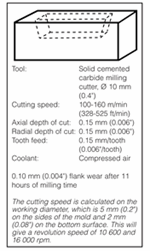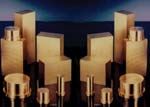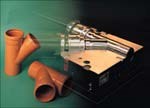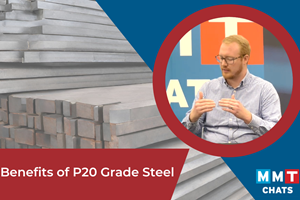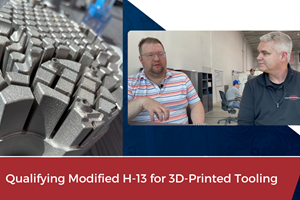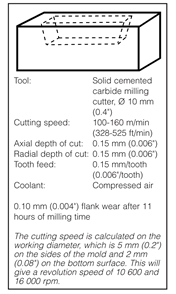It's a Material World
Strength, hardness and machinability are the common buzzwords that come into play when examining the new materials on the market.
Moldmakers are constantly on the lookout for the newest and best materials to build their molds with—and mold material manufacturers are rising to the occasion with tool steels and alloys that offer greater surface hardness, higher strength, better weldability, higher polishability and easier machinability. All of these advances add up to savings for the moldmaker in terms of lower part costs due to decreased cycle times and less wear and tear on the molders' molding machines. Here is what a number of material manufacturers had to say about the trends in mold material as well as the answers to some commonly asked questions about mold material.
1. What major advancements to you foresee in mold material this year? How will these advancements affect the moldmaker, mold designer and the moldmaking process?
John M. Perryman, national product manager, Copper and Brass Sales (Southfield, MI): I see large advancements being made in aluminum mold materials in regards to surface hardness and higher strength. Along with this will come aluminum alloys that will have much better uniformity through thickness hardness after heat treating up to and over 12" thick material. These alloys—with increased mechanical properties—will still carry the very high thermal conductivity that people have become accustomed to when using aluminum alloys. Further, great strides will be made in decreasing the corrosion susceptibility of many high strength aluminum alloys. In these aluminum alloys, moldmakers will see higher machining feeds and speeds accompanied by better machined surface finishes, resulting in machining and finishing cost savings. The designers will have greater flexibility in the use of aluminum in replacement of steel, which also would allow them to place water lines and other dimensions similar to that of steel injection molds.
Bob Mang, North American product manager non-ferrous products, ThyssenKrupp Specialty Steels (Clinton Township, MI): Major automotive OEMs are now willing to looking at alternative materials to P20 for use in production tooling. These advancements will make the moldmaker, mold designer and the moldmaking process more versatile. No longer will a mold shop just be able to build steel tools—they must adapt to other material and processes.
Ed Severson, technical manager for plastics applications, Bohler-Uddeholm Corp. (Rolling Meadows, IL): One ongoing trend is the increased demand from the end users to have tools that pass initial part approval perfectly and are expected to run for a specified time with no issues. This has forced the moldmakers to insist on mold materials with improved levels of polishability, toughness and weldability.
Cliff Moberg, president/vice president, Performance Alloys/Performance Mold Products (Germantown, WI): Due to the ever-increasing significance of workplace safety as well as company liability, there will be renewed emphasis regarding safe handling, machining and disposal of beryllium copper by companies either using, considering using or have moved away from using beryllium-copper alloys as a mold construction material. Circumstances certainly warrant—at minimum—compliance and adherence to OSHA/NIOSH safety guidelines. We are continuing to expand our product offerings of beryllium-free copper alloys that successfully replace beryllium copper products—helping users avoid the entire beryllium issue.
Paul Britton, International Mold Steel (Florence, KY): We have a new die steel, which can be heat treated to 62/64 HRC and will outlast H-13, S-7 molds. Some of our customers are starting to use this material for plastic and rubber molding.
Doug Veitch, director application engineering and marketing—plastics/tooling, Brush Wellman, Inc. (Cleveland, OH): One advancement in mold materials arose out of the preference some moldmakers have to work with non-beryllium containing materials. Our copper mold alloy responds to that preference while still providing excellent machinability, which can reduce mold build time. We have found that copper alloys machined on high-speed machines can achieve machining speeds and feeds similar to aluminum.
Some recent concerns in the moldmaking industry are the escalating costs of raw materials—resulting in higher plastic resin prices. The molding community needs to drastically reduce costs, and one of the few ways left is to use improved mold materials that provide lower cycle times. Mold materials may prove more expensive initially, but the payback is often less than six months due to higher productivity.
Offering mold alloys in a large plate form was a response to the need for manufacturers of large plastic parts to have the ability to use high strength, high conductivity copper alloys for large mold applications. This allows for a reduction in cycle time and scrap rates in all full core and cavity applications. You can now produce molds from a single block of metal as opposed to using a group of sub-inserts. This provides better integrity for the mold build, reducing mold maintenance and simplifying mold design.
2. What are the most common questions moldmakers ask about mold material? What are your answers? What common challenges do moldmakers face with mold material today?
Perryman, Copper and Brass Sales: The most common questions today that are asked by injection moldmakers about non ferrous mold materials revolve around the ability to withstand the wear caused by abrasive resins, the ability to hold up on the parting lines, the thermal conductivity of the mold materials and the ability of the mold to withstand abuse by the molders. The blow moldmakers are very concerned about intergranular corrosion in the water lines, which leads to closing up of the water lines and possible cracks into the cavities and galvanic corrosion caused by dissimilar metals, when using aluminum alloys.
Whereas, very abrasive resins can scratch and mar the surfaces of many aluminum and copper alloys, there are many common resins, which are extensively used today where this is not a problem. Many of these resins are very suitable to be used in non ferrous cavities without damage to the surface even through millions of injection molding cycles. Many molders think that you must put extremely high clamping pressures on the aluminum molds to prevent flashing in the molds. High strength aluminum and copper alloys can easily withstand clamping pressures required to keep the mold closed. Furthermore, you can design non ferrous molds and protect the parting lines in many ways such as steel inserts in the A and B plates. The thermal conductivity of the aluminum and copper alloys are anywhere from two to 10 times higher than steel alloys so they transfer the heat from the resin to the water lines much faster than steel, which reduces the cycle times.
Corrosion issues are much more complex than most moldmakers realize and involve several different types of problems. The intergranular corrosion is usually caused by poor water conditions or poor chemicals added to the water. Much of this corrosion can be controlled and converted to non-destructive pitting corrosion through manufacturing controls on the material. This also prevents the propagation of cracks in the molds or stress corrosion cracking. These cracks can be imitated by three factors that must all be present: stress, corrosion conditions and material susceptibility. By eliminating the material susceptibility, you can minimize the problems. Galvanic corrosion can be controlled in somewhat similar fashion as well as the separation of the dissimilar metals by coatings or some other barriers.
Mang, ThyssenKrupp: How can you reduce my costs of my tools? You try to get them not to look at price per pound, but to look at thermal conductivity, machining and other costs that go along with the cost of a tool. Moldmaking challenges include the rising prices of steel and aluminum and how to pass those costs along to their customers. They must be on the cutting edge of mold material to differentiate themselves from their competition.
Moberg, Performance Alloys/Performance Mold Products: Stability in pricing and availability. Due to the economic climate in the last four years, mills and warehouses had been keeping supplies hand to mouth. Many were and are not prepared for the recent surge in business. Feedstock prices, the lower dollar value and offshore demand for products and capacities has had a definite impact on the U.S. market as well, and these factors have collectively impacted at the same time. Combine that with the increase in business and there is a recipe for disaster. The challenge there becomes quoting enough for raw materials—and then if you get the job—shopping until you find the material in the time frame needed.
Britton, International Mold Steel: How much? When can I get it? Other than that, not much is really asked about mold steels. That is a real shame because in the case of P20, all materials are different. These differences can greatly increase or decrease a moldmaker's cost of building tools. That is one of the biggest problems facing today's moldmaking industry. The other is foreign competition. However, if we can understand the materials we are using then we will have the edge when it comes to foreign competition.
Veitch, Brush Wellman: Coating and whether our material can be coated. Yes, it can be and we provide a list of viable methods of surface treatment for improving wear. Other questions include:
- Do copper alloys provide a more uniform tool temperature? Yes—in addition to faster heat removal, they also can provide greater uniformity of tool temperature compared to P20 or H13. Infrared technology imaging is one way to see the uniform cooling. It allows a series of snapshots to capture the thermal fingerprint of plastic parts in real time as they come out of the press. From those snapshots the thermal data, along with experts who read the data, can recommend and discuss mold design changes that will create a more uniform thermal image across the part.
- Is Copper Beryllium (CuBe) safe to machine? Yes. If moldmakers ensure they work with a supplier that is dedicated to health and safety workplace practices, they will be provided with the essential literature and procedures to ensure safety.
- Where are the best places to insert copper alloys to optimize tool performance? Through working with a knowledgeable supplier, moldmakers will have access to technical teams who can recommend the size and location of inserts to give the best performance and cost.
Despite the fact that it is a challenging market out there, mold material manufacturers and suppliers are more than rising to the occasion by meeting moldmakers' requests for higher quality materials with material offerings that feature more toughness, better weldability and higher levels of polishability—adding up to shorter cycle times, less mold maintenance and a higher quality mold.
Related Content
Advancing Moldmaking and Plastics: Trends in 3D Printing, Automation and Sustainability
NPE 2024 showcased the latest trends and technologies in innovation, efficiency and sustainability for moldmakers and molders, featuring advancements in 3D printing, automation, design and virtual reality/augmented reality/artificial intelligence.
Read MoreMicro-Milled Steel Plate Cuts Mold Build Times by 10-15%
Steel 21 emphasizes its tighter tolerances, improved surface quality and speed of processing using the patented “21 Micro Milling” process.
Read MoreProject Reveals Added Benefits of New P20 Grade Steel in Machinability, Cycle Time and No Stress Relief
MoldMaking Technology's Christina Fuges talks with General Motors' Shane Appel about a project testing a new P20 steel grade's dimensional stability.
Read MoreVIDEO: Qualifying Modified H-13 for 3D-Printed Tooling
Next Chapter Manufacturing and International Mold Steel discuss their partnership to qualify a modified H-13 for tooling applications.
Read MoreRead Next
Cost Savings for Mold Materials: Consider the Details
Ways to reduce costs that are not related to the price per pound of the mold material.
Read MoreHow to Use Strategic Planning Tools, Data to Manage the Human Side of Business
Q&A with Marion Wells, MMT EAB member and founder of Human Asset Management.
Read MoreHow to Use Continuing Education to Remain Competitive in Moldmaking
Continued training helps moldmakers make tooling decisions and properly use the latest cutting tool to efficiently machine high-quality molds.
Read More
